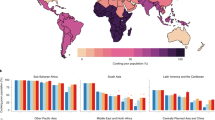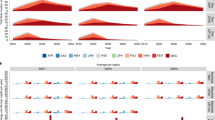Abstract
Three billion of the world’s poorest people mostly rely on solid biomass for cooking, with major consequences to health1 and environment2. We demonstrate the untapped potential of wireless sensors connected to the ‘internet of things’ to make clean energy solutions affordable for those at the bottom of the energy pyramid. This breakthrough approach is demonstrated by a 17-month field study with 4,038 households in India. Major findings include: self-reported data on cooking duration have little correlation with actual usage data from sensors; sensor data revealed that the distribution of high and low users varied over time, and the actual mitigation of climate pollution was only 25% of the projected mitigation; climate credits were shown to significantly incentivize the use of cleaner technologies.
This is a preview of subscription content, access via your institution
Access options
Subscribe to this journal
Receive 12 print issues and online access
$209.00 per year
only $17.42 per issue
Buy this article
- Purchase on Springer Link
- Instant access to full article PDF
Prices may be subject to local taxes which are calculated during checkout




Similar content being viewed by others
References
Lim, S. S. et al. A comparative risk assessment of burden of disease and injury attributable to 67 risk factors and risk factor clusters in 21 regions, 1990–2010: a systematic analysis for the Global Burden of Disease Study 2010. Lancet 380, 2224–2260 (2013).
Anenberg, S. C. et al. Cleaner cooking solutions to achieve health, climate, and economic cobenefits. Environ. Sci. Technol. 47, 3944–3952 (2013).
Barnes, D. F., Kumar, P. & Openshaw, K. Cleaner Hearths, Better Homes: New Stoves for India and the Developing World (Oxford University Press The World Bank, 2012).
Rehman, I. H., Ahmed, T., Praveen, P. S., Kar, A. & Ramanathan, V. Black carbon emissions from biomass and fossil fuels in rural India. Atmos. Chem. Phys. 11, 7289–7299 (2011).
Ramanathan, V. & Carmichael, G. Global and regional climate changes due to black carbon. Nat. Geosci. 1, 221–227 (2008).
Streets, D. G., Shindell, D. T., Lu, Z. & Faluvegi, G. Radiative forcing due to major aerosol emitting sectors in China and India. Geophys. Res. Lett. 40, 4409–4414 (2013).
IPCC Climate Change 2013: The Physical Science Basis (eds Stocker, T. F. et al.) (Cambridge Univ. Press, 2013).
Integrated Assessment of Black Carbon and Tropospheric Ozone: Summary for Decision Makers (UNEP and Wold Meterological Organization, 2011); http://www.unep.org/dewa/Portals/67/pdf/Black_Carbon.pdf
Bond, T. C. et al. Bounding the role of black carbon in the climate system: a scientific assessment. J. Geophys. Res. 118, 5380–5552 (2013).
Jain, A., Choudhury, P. & Ganesan, K. CEEW Report: Clean, Affordable and Sustainable Cooking Energy for India (Council on Energy, Environment, and Water, 2015).
Patange, O. S. et al. Reductions in indoor black carbon concentrations from improved biomass stoves in rural India. Environ. Sci. Technol. 49, 4749–4756 (2015).
Kar, A. et al. Real-time assessment of black carbon pollution in Indian households due to traditional and improved biomass cookstoves. Environ. Sci. Technol. 46, 2993–3000 (2012).
MacCarty, N., Ogle, D., Still, D., Bond, T. C. & Roden, C. A laboratory comparison of the global warming impact of five major types of biomass cooking stoves. Energy Sustain. Dev. 12, 56–65 (2008).
Freeman, O. E. & Zerriffi, H. How you count carbon matters: implications of differing cookstove carbon credit methodologies for climate and development cobenefits. Environ. Sci. Technol. 48, 14112–14120 (2014).
Aung, T. W. et al. Health and climate-relevant pollutant concentrations from a carbon-finance approved cookstove intervention in rural India. Environ. Sci. Technol. 50, 7228–7238 (2016).
Graham, E. A. et al. Laboratory demonstration and field verification of a Wireless Cookstove Sensing System (WiCS) for determining cooking duration and fuel consumption. Energy Sustain. Dev. 23, 59–67 (2014).
Hanna, R., Duflo, E. & Greenstone, M. Up in Smoke: The Influence of Household Behavior on the Long-run Impact of Improved Cooking Stoves (National Bureau of Economic Research, 2012).
Lewis, J. J. & Pattanayak, S. K. Who adopts improved fuels and cookstoves? A systematic review. Environ. Health Perspect. 120, 637–645 (2012).
Ruiz-Mercado, I., Masera, O., Zamora, H. & Smith, K. R. Adoption and sustained use of improved cookstoves. Energy Policy 39, 7557–7566 (2011).
Pillarisetti, A. et al. Patterns of stove usage after introduction of an advanced cookstove: the long-term application of household sensors. Environ. Sci. Technol. 48, 14525–14533 (2014).
Thomas, E. A., Barstow, C. K., Rosa, G., Majorin, F. & Clasen, T. Use of remotely reporting electronic sensors for assessing use of water filters and cookstoves in Rwanda. Environ. Sci. Technol. 47, 13602–13610 (2013).
United Nations Framework Convention on Climate Change: Adoption of the Paris Agreement (United Nations Framework Convention on Climate Change, 2015); http://unfccc.int/resource/docs/2015/cop21/eng/l09r01.pdf
Ministry of New and Renewable Energy National Biomass Cookstoves Programme (Ministry of New and Renewable Energy, Government of India, 2016); http://mnre.gov.in/schemes/decentralized-systems/national-biomass-cookstoves-initiative
State of Forest Report 2011 Socio-Economic Contribution of Forests: Production and Consumption of Forest Resources in India 67–79 (Forest Survey of India, Ministry of Environment & Forests, 2011).
Venkataraman, C., Sagar, A. D., Habib, G., Lam, N. & Smith, K. R. The Indian national initiative for advanced biomass cookstoves: the benefits of clean combustion. Energy Sustain. Dev. 14, 63–72 (2010).
AMS II-G Small Scale Methodology Energy Efficiency Measures in Thermal Applications of Non-Renewable Biomass (United Nations Framework Convention on Climate Change, 2014); https://cdm.unfccc.int
Akagi, S. K. et al. Emission factors for open and domestic biomass burning for use in atmospheric models. Atmos. Chem. Phys. 11, 4039–4072 (2011).
Meinshausen, M. et al. Greenhouse-gas emission targets for limiting global warming to 2 °C. Nature 458, 1158–1162 (2009).
Ramanathan, V. & Xu, Y. The Copenhagen Accord for limiting global warming: criteria, constraints, and available avenues. Proc. Natl Acad. Sci. USA 107, 8055–8062 (2010).
State and Trends of Carbon Pricing (World Bank Group, 2014); http://www.worldbank.org/content/dam/Worldbank/document/Climate/State-and-Trend-Report-2015.pdf
Acknowledgements
C2P2 was initiated by Project Surya, an international collaboration between University of California, San Diego, Nexleaf Analytics and The Energy and Resources Institute. The primary funding for this work was provided by L. and M. McQuown, with additional funding from Qualcomm Wireless Reach, UK DFID, Beneventures Foundation, J. and E. Frieman, and C. Kennel & E. Lehman. Project Surya was started by funding from National Science Foundation (J. Fein) and incubated at UNEP beginning 2009. We are indebted to M. Lawrence whose comments significantly enhanced the clarity of presentation. In addition we thank M. Lawrence for suggesting the field survey. We acknowledge M. Lukac for developing the WiCS. We acknowledge G. Dalai, B. Dash, M. Singh, A. Mohd, L. Singh, the staff of Saunta Gaunta Foundation and the TERI field team for stove and sensor installation, beneficiary engagement and data collection. The data for Fig. 1 were collected as part of a study led by S. Pattanayak. The focus group instrument was designed with B. Augsburg. J. Ross supported the data analysis, and E. Wu and S. Maltz helped edit the paper.
Author information
Authors and Affiliations
Contributions
N.R., V.R. and I.H.R. designed the original version of this study. All authors contributed to refinement of the original design and conception of the field study. I.H.R. led the field study; J.M. and T.R. collected data in the field; and J.M. led the payments to women. T.R. and N.R. led the sensor deployment; and T.R., N.R. and E.G. conducted the data analysis. T.R., N.R. and V.R. took the lead in writing the paper.
Corresponding author
Ethics declarations
Competing interests
The authors declare no competing financial interests.
Supplementary information
Supplementary Information
Supplementary Information (PDF 3583 kb)
Rights and permissions
About this article
Cite this article
Ramanathan, T., Ramanathan, N., Mohanty, J. et al. Wireless sensors linked to climate financing for globally affordable clean cooking. Nature Clim Change 7, 44–47 (2017). https://doi.org/10.1038/nclimate3141
Received:
Accepted:
Published:
Issue Date:
DOI: https://doi.org/10.1038/nclimate3141
This article is cited by
-
Pervasive over-crediting from cookstove offset methodologies
Nature Sustainability (2024)
-
Visualization and analysis of mapping knowledge domains for the global transition towards clean cooking: a bibliometric review of research output from 1990 to 2020
Environmental Science and Pollution Research (2022)
-
Experience and Learning with Improved Technologies: Evidence from Improved Biomass Cookstoves in Ethiopia
Environmental and Resource Economics (2022)



